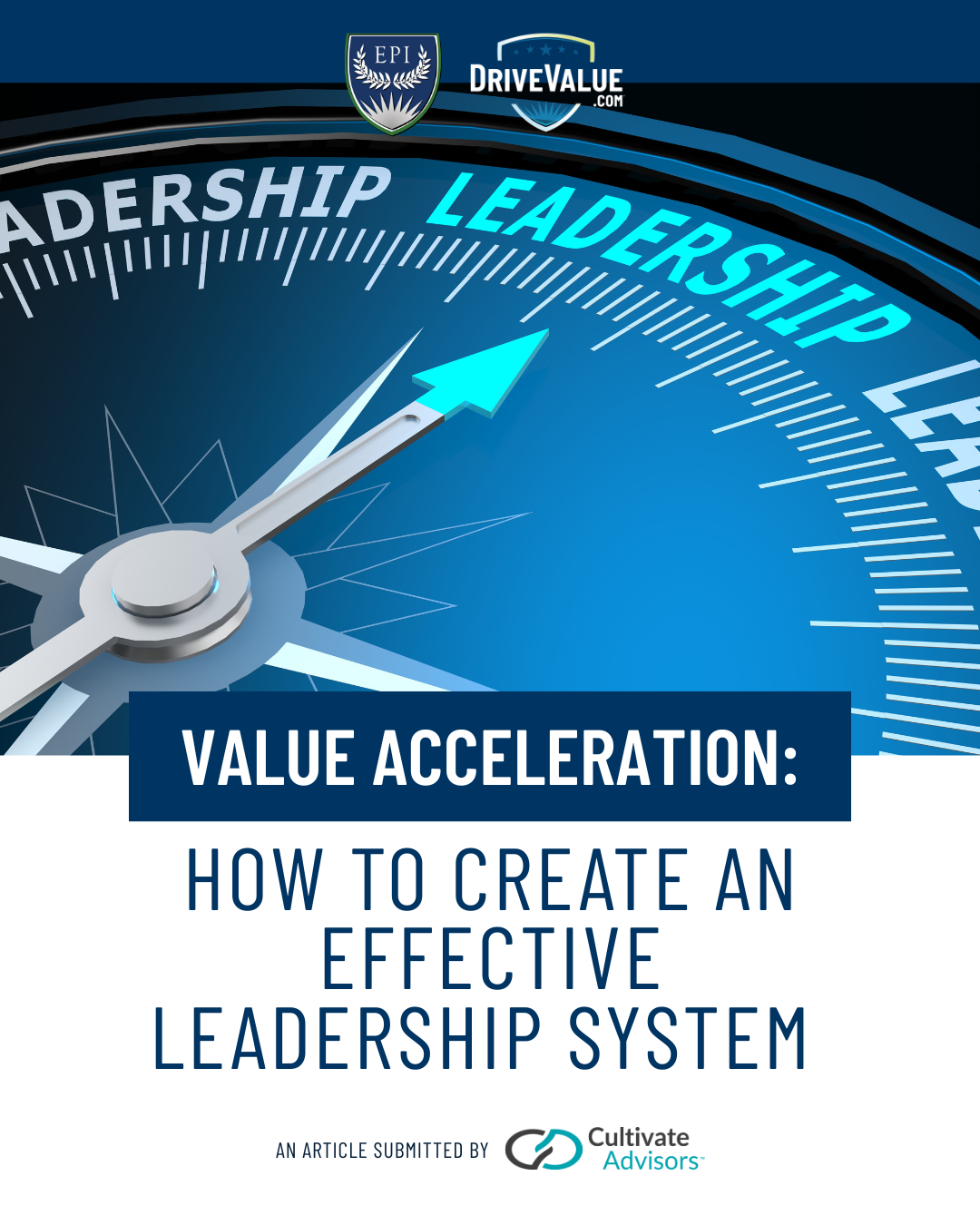
THE EXIT PLANNING BLOG
Keep up-to-date with exit planning, succession planning, industry trends, unique specialty insights, and useful content for professional advisors and business owners.
Share this
Value Acceleration: How to Create an Effective Leadership System
by Jeff Armstrong on October 27, 2025

Author and educator Peter F. Drucker once said, “Management is doing things right; leadership is doing the right things.”
Successful organizations are built on effective leadership. But no leader is perfect; there’s always room to grow. Developing your leadership skills and building a strong leadership system is one of the best investments you can make in your business.
For business owners working with a Certified Exit Planning Advisor (CEPA®), leadership is also a critical driver of transferable value and the Value Acceleration Methodology™. One of the most common risks uncovered in exit planning is overreliance on the owner. Without a leadership system in place, the business cannot scale, and its value remains tied too closely to a single individual. Strengthening leadership systems creates consistency, reduces risk, and positions a company to thrive beyond the owner.
What Is a Leadership System?
A leadership system is the way leadership is exercised, formally and informally, throughout an organization. It guides how critical decisions are made, communicated, and executed.
An effective leadership system respects your team’s capabilities, sets clear expectations, and promotes accountability, teamwork, and loyalty around shared business goals. Without one, organizations often lack consistency and struggle to move forward together.
Simply put, leadership systems create clarity and alignment, ensuring both leaders and employees know what is expected and how to achieve it.
10 Strategies for Effective Leadership
Great leaders inspire, motivate, and create environments where people feel valued. Here are ten strategies to help you lead effectively and build a leadership system that works.
1. Identify Your Goals
Your company’s vision is the foundation of your leadership system. It articulates the purpose of your business and provides a roadmap for decision-making. Without a clear vision, your team may lack direction.
If you haven’t already, take time to outline your vision. When your goals are clear, your team has a collective purpose to rally around.
2. Develop Trust
Trust is the foundation of effective leadership. Without it, employees doubt the company, disengage, and lose pride in their work.
You can build trust by:
- Leading by example
- Communicating openly
- Encouraging honest dialogue
- Listening actively
- Avoiding blame and focusing on solutions
Trust takes time, but the payoff is higher retention, better performance, and stronger morale.
3. Encourage Collaboration
Collaboration thrives when people feel safe sharing ideas and know their contributions are valued. Leaders can foster this by:
- Creating open channels for dialogue
- Supporting cross-functional projects
- Recognizing collaborative achievements
When collaboration becomes part of the culture, innovation and problem-solving accelerate.
4. Create Buy-In
Even great ideas can fall flat without buy-in from your team. The execution of any initiative depends on both the quality of the idea and the enthusiasm of those carrying it out.
To build buy-in:
- Clearly explain the “why” behind initiatives
- Show how the idea benefits both the company and the team
- Invite input and feedback early in the process
5. Be Proactive
Effective leaders don’t just respond to change. They anticipate it. Being proactive means identifying challenges and opportunities before they arise.
This mindset empowers your team to take initiative and feel ownership of their work, leading to stronger engagement and pride in outcomes.
6. Stay Accountable
Accountability creates a culture of ownership and clarity. When expectations are clear and measurable, employees understand how their contributions fit into the bigger picture.
Accountability, not micromanaging, is about providing structure, support, and alignment so your team can perform at its best.
7. Build Your Leadership System
Once you’ve established trust, accountability, and buy-in, you can formalize your leadership system.
This involves:
- Defining roles and responsibilities
- Establishing clear performance measures (KPIs)
- Creating consistent communication processes
Every business is unique, so leadership systems must be tailored. Clarity is key. When everyone knows their role and expectations, the organization runs more smoothly.
8. Develop Your People
Investing in your team’s growth pays long-term dividends. Professional development boosts performance, reduces turnover, and builds loyalty.
Employees who feel supported in their growth are more engaged and committed. Ongoing training, mentorship, and recognition are all powerful tools for development.
9. Embrace Change
The only constant in business is change. Leaders who resist it risk stagnation, while leaders who embrace it position their organizations for growth.
Being open to new ideas, transparent about why changes are happening, and responsive to team concerns helps build resilience.
10. Commit to Continuous Development
Finally, great leaders are always learning. Development planning, both for yourself and your team, ensures long-term growth.
By aligning personal goals with company goals, you create a pathway for leadership succession, stronger morale, and sustained business success.
Bringing It All Together
Whether you’re leading a small team or a large organization, it’s never too late to strengthen your leadership system. For owners preparing for an eventual transition, leadership is one of the most important value drivers. Buyers and successors want confidence that the business can run without you.
By setting clear goals, fostering trust, encouraging collaboration, and committing to continuous development, you’ll create an environment where your team thrives and your business reaches its full potential.
Effective leadership isn’t about being perfect. It’s about building systems that support your people, reduce owner dependency, and align everyone toward a shared vision. For CEPAs guiding owners through the Value Acceleration Methodology™, strengthening leadership is not just about good management—it’s about building transferable value and creating options for the future.
Related Resources
- How to Turn Your Business Into a Freedom Machine, No Sale Required
- How Financial Advisors Can Help Business Owners Build Significant Companies and Create Legacy
- About Our Partner Network
Share this
- Blog (544)
- CEPA (419)
- exit planning (249)
- CEPA community (187)
- Business Owner (169)
- Exit Planning Summit (95)
- EPI Chapter Network (89)
- Value Acceleration Methodology (79)
- Exit Planning Partner Network (76)
- EPI Announcement (49)
- Content (48)
- Webinars (37)
- Excellence in Exit Planning Awards (33)
- Marketing (30)
- 2024 Exit Planning Summit (28)
- 5 Stages of Value Maturity (26)
- Books (24)
- EPI Academy (24)
- EPI Team (22)
- Exit Planning Teams (22)
- Leadership (21)
- 2023 Exit Planning Summit (20)
- family business (20)
- women in business (19)
- Intangible Capital (18)
- Exit Options (17)
- Black Friday (16)
- CPA (15)
- Walking to Destiny (15)
- State of Owner Readiness (14)
- Chapters (13)
- Chris Snider (12)
- National Accounts (12)
- Small business (12)
- charitable intent (12)
- personal planning (12)
- Financial Advisors (11)
- Season of Deals (9)
- 5 Ds (8)
- About us (8)
- Podcast (8)
- Insiders Bash (7)
- Scott Snider (7)
- Christmas (6)
- Exit Planning Content Library (6)
- Case Studies (5)
- Owner Roundtables (5)
- Value Advisors (5)
- financial planning (5)
- Awards (4)
- Circle of Excellence (4)
- Exit & Succession (4)
- Five Ds (4)
- Three Legs of the Stool (4)
- executive training (4)
- Owners Forum (3)
- author (3)
- forbes (3)
- DriveValue (2)
- EPI Thought Leadership Council (2)
- Exit Is Now Podcast (2)
- Peter Christman (2)
- Veteran (2)
- Whitepapers (2)
- Business Owners Forum (1)
- SOOR (1)
- business consultants (1)






